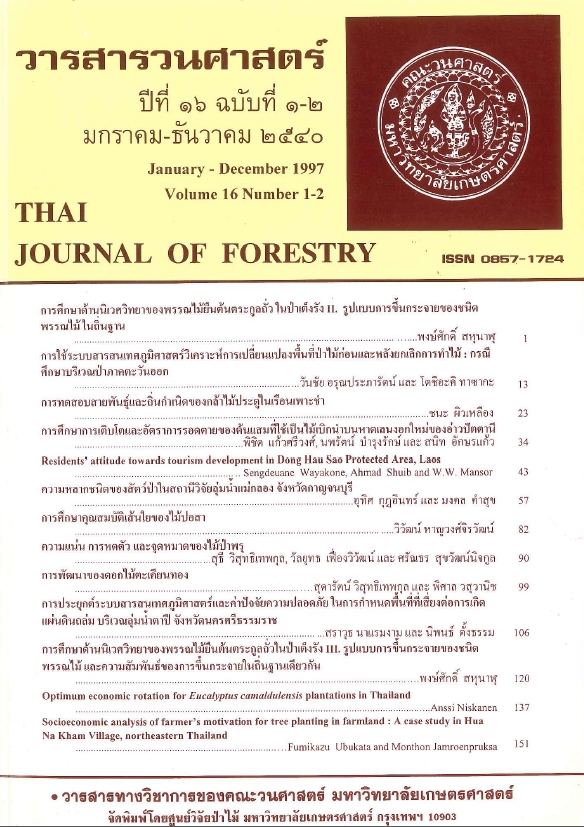การพัฒนาของดอกไม้ตะเคียนทอง
Main Article Content
บทคัดย่อ
การศึกษาการพัฒนาของคอกไม้ตะเคียนทอง ได้ทำตั้งแต่ระยะการเป็นตาดอกจนกระทั่งดอกได้รับการผสมพันธุ์ โดยทำการเก็บตัวอย่างตั้งแต่กลางเดือนธันวาคม 2538 ถึงปลายเดือนมกราคม 2539 ดอกย่อยแต่ละดอกเป็นดอกสมบูรณ์ ประกอบด้วย กลีบเลี้ยง กลีบดอก เกสรตัวผู้ และเกสรตัวเมีย ในระยะดอกตูม เกสรตัวผู้มีการเจริญมาจากเนื้อเยื่อส่วนกลาง และเจริญพัฒนาเป็นอับละอองเกสรตัวผู้และก้านชูเกสรตัวผู้ เมื่อดอกมีขนาดใหญ่ขึ้น sporogenous cells ได้มีการแบ่งเซลล์และพัฒนาเป็นละอองเกสรตัวผู้อยู่ภายในอับละอองเกสร ในขณะเดียวกันเกสรตัวเมีย มีการเจริญมาจากเนื้อเยื่อส่วนกลางแล้วพัฒนาไปเป็น ยอดเกสรตัวเมีย ก้านเกสรตัวเมีย และรังไข่ ภายในรังไข่มี 6 ovule บรรจุใน 3 locule โดยเรียงตัวแบบ anatropous ovule ในระยะดอกบาน megaspore mother cell ของแต่ละ ovule จะมีการแบ่งเซลล์จนเป็น linear tetrad เ megaspore และ 1 ใน 4 เซลล์นี้ พัฒนาต่อไปเป็น embryo sac ภายใน embryo sac มี 8 nuclei ได้แก่ egg apparatus, 2 polar nuclei และ 3 anipodal จากการพัฒนาของดอกตั้งแต่ระยะตาออกจนกระทั่งดอกได้รับการผสมแล้วใช้เวลา 40 - 45 วัน หลังจากการผสมเกสรแล้ว egg เจริญไปเป็น zygole และ zygote มีการแบ่งเซลล์เป็น embryo ที่มีรูปร่างลักษณะคล้ายตัว “T” อยู่ภายใน ovule
Downloads
Article Details

อนุญาตภายใต้เงื่อนไข Creative Commons Attribution-NonCommercial-NoDerivatives 4.0 International License.
ข้าพเจ้าและผู้เขียนร่วม (ถ้ามี) ขอรับรองว่า ต้นฉบับที่เสนอมานี้ยังไม่เคยได้รับการตีพิมพ์และไม่ได้อยู่ในระหว่างกระบวนการพิจารณาตีพิมพ์ลงในวารสารหรือสิ่งตีพิมพ์อื่นใด ข้าพเจ้าและผู้เขียนร่วม (ถ้ามี) ยอมรับหลักเกณฑ์และเงื่อนไขการพิจารณาต้นฉบับ ทั้งยินยอมให้กองบรรณาธิการมีสิทธิ์พิจารณาและตรวจแก้ต้นฉบับได้ตามที่เห็นสมควร พร้อมนี้ขอมอบลิขสิทธิ์ผลงานที่ได้รับการตีพิมพ์ให้แก่วารสารวนศาสตร์ คณะวนศาสตร์ มหาวิทยาลัยเกษตรศาสตร์ กรณีมีการฟ้องร้องเรื่องการละเมิดลิขสิทธิ์เกี่ยวกับภาพ กราฟ ข้อความส่วนใดส่วนหนึ่ง หรือ ข้อคิดเห็นที่ปรากฏในผลงาน ให้เป็นความรับผิดชอบของข้าพเจ้าและผู้เขียนร่วม (ถ้ามี) แต่เพียงฝ่ายเดียว และหากข้าพเจ้าและผู้เขียนร่วม (ถ้ามี) ประสงค์ถอนบทความในระหว่างกระบวนการพิจารณาของทางวารสาร ข้าพเจ้าและผู้เขียนร่วม (ถ้ามี) ยินดีรับผิดชอบค่าใช้จ่ายทั้งหมดที่เกิดขึ้นในกระบวนการพิจารณาบทความนั้น”


